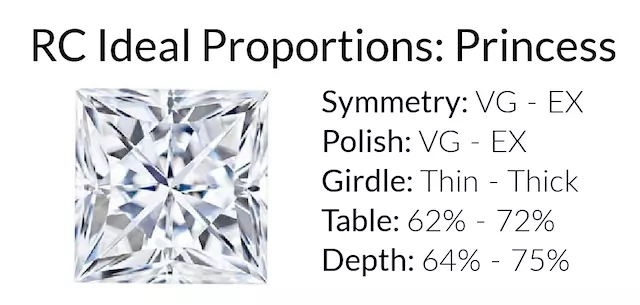What is Rare Carat Ideal cut diamond?
You may have noticed that under the cut grade section for a diamond, some of the stones have Rare Carat Ideal listed rather than Excellent (natural) or Ideal (lab grown). No, this isn’t a new cut grade from the GIA (although it would be super cool if it was) but rather a select set of criteria that shows us a diamond has been exceptionally cut. After all, cut is definitely the most important of the 4C’s.
Our team of graduate gemologists has taken their collective years of experience and training to devise a strict standard for each diamond shape and we’ve packaged it up nicely for you in the Rare Carat Ideal cut grade. We took all of the hard work out to make shopping for your diamond as hassle-free as possible!
So What is the Rare Carat Ideal cut grade?

Each diamond shape has a different set of parameters, which I’ll list below, but it’s essentially a filter that you can set on the search page, over on the cut grade slider, to set the ideal cut (round only), polish, symmetry, depth percentage, crown angle (for rounds), table percentage and girdle thickness. Back in the day, we used to have to set all of these important aspects by hand, but not anymore thanks to our genius tech team (thanks guys and gals, you rock)!
Before I give you the ideal proportions for each shape, let’s go through what each one of them means.

Cut: This is the most important of the 4C’s – it’s where all of the sparkle and shine comes from! The cut takes into consideration the overall design, craftsmanship and appearance. A well cut diamond is going to have more sparkle, shine and brightness than a poorly cut stone.
Polish: The polish tells us how smooth and shiny the surface is. A high polish grade means you’ll have a diamond with no detectable flaws that could interrupt the light return. A lower polish grade tells us the diamond has visible surface blemishes which could include burn marks and severe polish lines.
Symmetry: The symmetry grade tells us how well aligned and shaped the facets are. We want a diamond with facets that line up as perfectly as possible so the light can bounce around at all the right angles and bring sparkle to our eyes. A stone with a lower symmetry grade will have facets that are misshapen and poorly aligned.
Depth Percentage: The depth percentage tells us how deep or shallow the diamond is cut. It's measured from the table to the culet. If a diamond is cut too deep, there will be wasted carat weight sitting in the bottom of the stone that we can’t see. Cut it too shallow and you get a big visual appearance, but the angles won’t be proportionate which will drastically impact the overall sparkle, shine and brightness.
Table Percentage: The table is the largest facet on the diamond and the one where most of the light enters and exits. If a table is too large, too much light will enter in the stone with nowhere to go. It’ll leak out the sides and bottom taking brightness and sparkle right along with it. If a table is too small, it won’t take in enough light and will cause it to appear dark as well.
Crown Angle: The crown angle measures the top portion of the stone. If it’s too steep, you’re going to have a diamond that looks like a snow cone. It’ll be really big and very top heavy. Not only does this affect the appearance, it affects the brightness and light return as well. If it’s too flat, you’re going to have a diamond that looks a little like a pancake up top. It’ll make the stone brighter but takes away a ton of sparkle.
Girdle Thickness: The girdle is the separation plane between the crown (top) and pavilion (bottom) of the diamond. If a girdle is too thick, there will be wasted carat weight sitting around the middle of the stone. Not only will it make the stone look bulky and disproportionate, but it’ll also cause some issues with keeping it secure in the setting. Too thin, and it risks the stone getting chipped or broken if hit just right (and believe me, diamonds get whacked all the time and we don’t even realize we are doing it).
Alrighty, now that we had a little education sesh, it's time to list the ideal proportions for each diamond shape! (Pro Tip: Click on each image to read more about that shape).
 ](https://www.rarecarat.com/education/shape/the-round-cut)
](https://www.rarecarat.com/education/shape/the-round-cut)
 ](https://www.rarecarat.com/education/shape/the-cushion-cut)
](https://www.rarecarat.com/education/shape/the-cushion-cut)
 ](https://www.rarecarat.com/education/shape/the-oval-cut)
](https://www.rarecarat.com/education/shape/the-oval-cut)
 ](https://www.rarecarat.com/education/shape/the-princess-cut)
](https://www.rarecarat.com/education/shape/the-princess-cut)
 ](https://www.rarecarat.com/education/shape/the-pear-cut)
](https://www.rarecarat.com/education/shape/the-pear-cut)
 ](https://www.rarecarat.com/education/shape/the-marquise-cut)
](https://www.rarecarat.com/education/shape/the-marquise-cut)
 ](https://www.rarecarat.com/education/shape/what-you-need-to-know-about-emerald-shape-diamonds)
](https://www.rarecarat.com/education/shape/what-you-need-to-know-about-emerald-shape-diamonds)
 ](https://www.rarecarat.com/education/shape/the-radiant-cut)
](https://www.rarecarat.com/education/shape/the-radiant-cut)
 ](https://www.rarecarat.com/education/shape/the-asscher-cut)
](https://www.rarecarat.com/education/shape/the-asscher-cut)
Remember when you’re using our search page, all you have to do to get the above parameters set automatically, is to set the cut grade slider to Rare Carat Ideal. To see even better options, make sure to check the “Meets all Checks” box in the quality section.

I think you’re ready to start searching like a pro! If you have any questions, don’t hesitate to reach out to one of our gemologists for help! We can look over any diamond you have found or set up a custom search just for you.

